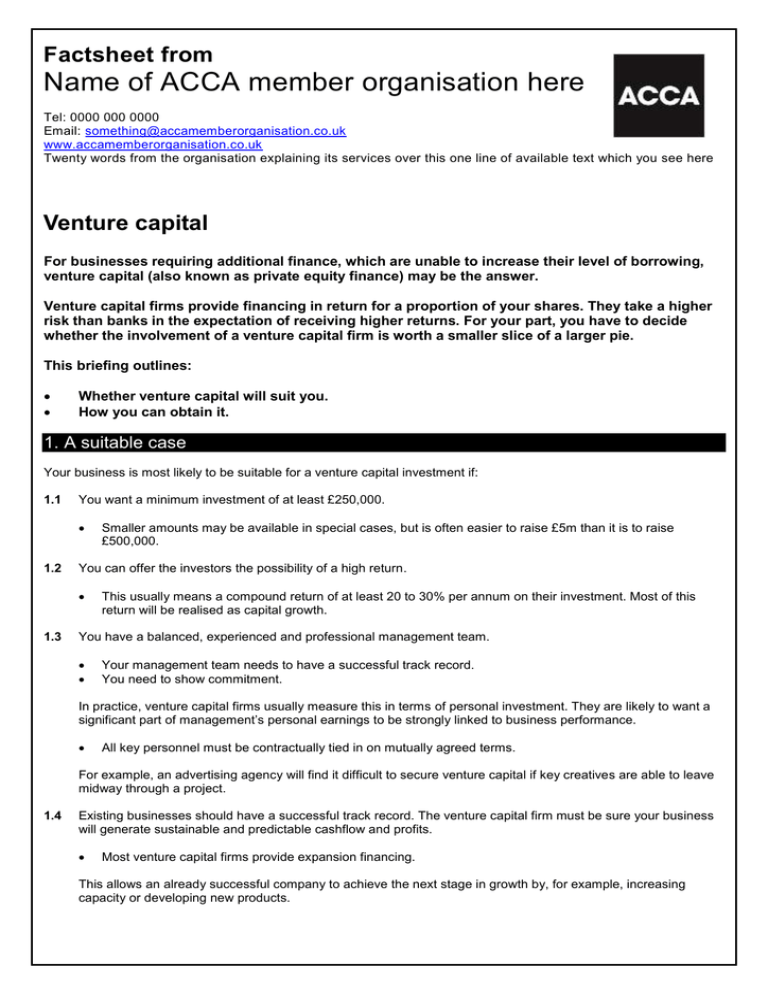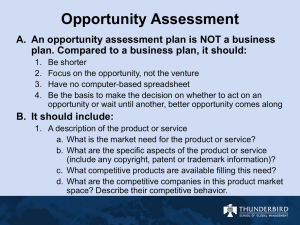
Factsheet from
Name of ACCA member organisation here
Tel: 0000 000 0000
Email: something@accamemberorganisation.co.uk
www.accamemberorganisation.co.uk
Twenty words from the organisation explaining its services over this one line of available text which you see here
Venture capital
For businesses requiring additional finance, which are unable to increase their level of borrowing,
venture capital (also known as private equity finance) may be the answer.
Venture capital firms provide financing in return for a proportion of your shares. They take a higher
risk than banks in the expectation of receiving higher returns. For your part, you have to decide
whether the involvement of a venture capital firm is worth a smaller slice of a larger pie.
This briefing outlines:
Whether venture capital will suit you.
How you can obtain it.
1. A suitable case
Your business is most likely to be suitable for a venture capital investment if:
1.1
You want a minimum investment of at least £250,000.
1.2
You can offer the investors the possibility of a high return.
1.3
Smaller amounts may be available in special cases, but is often easier to raise £5m than it is to raise
£500,000.
This usually means a compound return of at least 20 to 30% per annum on their investment. Most of this
return will be realised as capital growth.
You have a balanced, experienced and professional management team.
Your management team needs to have a successful track record.
You need to show commitment.
In practice, venture capital firms usually measure this in terms of personal investment. They are likely to want a
significant part of management’s personal earnings to be strongly linked to business performance.
All key personnel must be contractually tied in on mutually agreed terms.
For example, an advertising agency will find it difficult to secure venture capital if key creatives are able to leave
midway through a project.
1.4
Existing businesses should have a successful track record. The venture capital firm must be sure your business
will generate sustainable and predictable cashflow and profits.
Most venture capital firms provide expansion financing.
This allows an already successful company to achieve the next stage in growth by, for example, increasing
capacity or developing new products.
1.5
Finance is often provided for management buy-outs (MBOs) and management buy-ins (MBIs). An MBO
allows an existing business to be acquired by its current management team. With an MBI, an external
management team buys in.
Some exceptionally promising start-ups can attract venture capital to finance their development and
marketing costs.
You are able to provide an exit option. Most venture capital firms will want to realise their profits, typically within
three to seven years.
The most common exits are:
A trade sale to another company.
Refinancing of their investment by another institution.
A listing of the shares on an exchange, such as AIM or the Stock Exchange Main Market.
Repurchase of the venture capital firm’s shares by management.
Even if the venture capital firm is not going to exit, it will want to keep this option open
2. The drawbacks
2.1
Venture capital imposes certain constraints.
You will have to generate the cash needed to make the agreed payments of capital, interest and dividends
(see 3).
Specific legally binding covenants will be included in the investment agreement to protect the venture capital
firm.
For example, you may have to agree to limit the amount you are paid or to be prohibited from involvement with
other companies with conflicting interests. You may be required to obtain the venture capital firm’s approval
before making certain major decisions.
The venture capital firm may require a nominated representative on your board, typically as a non-executive
director.
This director may want to provide hands-on management if things are going wrong, but will usually only be
involved in strategic decisions.
The venture capital firm will expect regular information and consultation to check how things are progressing.
For example, monthly management accounts and minutes of board meetings.
2.2
Acquiring venture capital involves considerable expense.
Total costs of 10% or more of the amount raised are not uncommon for smaller investments, and 5% for larger
amounts.
2.3
You will need professional advice (see 6).
You will usually be required to pay the venture capital firm’s costs.
Acquiring venture capital involves considerable management time.
The whole process typically takes three to six months, though it can be much faster.
2.4
It is not unusual for business performance to decline during this time as management is distracted. This
should be addressed.
Investment deals can fail at the last moment. The most common reasons are:
2
Failure to agree a price or other key terms.
This is especially common when several investment firms join together (syndicate) to provide the necessary
finance.
Legal problems cannot be resolved.
Trading performance declines substantially during the process of raising investment.
3. Types of finance
3.1
Ordinary shares give the venture capital firm ownership of an agreed proportion of the company. The venture
capital firm’s return is made up of a combination of dividends (if any) and the increase in the capital value of the
shares.
Ordinary shares are cheap for the company to finance in the short term.
Dividends can be zero (unless the investment agreement specifies otherwise), but may be a contractual share of
profits.
Negotiations over the proportion of shareholding that the venture capital firm receives for an investment can
be long and difficult.
You will tend to value your company, and thus your shares, more highly than outsiders will.
3.2
Preference shares are similar to debt, as they pay a fixed dividend and are repaid on specified dates. But they
are unsecured.
Unlike debt, preference shares protect you against having to pay out cash while the company is making
losses (for example, while you are entering a new market).
You are prohibited by law from redeeming (repaying) preference shares or paying dividends on them unless the
company has generated sufficient profits (distributable reserves) to do so.
3.3
Debt consists of overdrafts, loans, hire purchase, leasing and other borrowings.
Debt is usually secured against specific assets (eg your premises or debtors).
If your company is unable to pay the capital repayments or the interest on time, the lender can sell those assets.
This could be disastrous and may cause the company to cease trading.
Usually you borrow from a bank, rather than from a venture capital firm. But some firms can provide loans,
leasing and hire purchase as well as equity finance.
4. Approaching investors
4.1
Determine how much finance you need to raise and what your timescales are.
How much other capital do you have access to?
Could you raise finance by other means?
For example, by selling and then leasing back property or other assets.
4.2
What level of capital and interest payments (and preference share dividends) can your cashflow support?
Prepare a professional business plan.
This needs to convince potential investors that your business has good prospects and that you know what you are
doing.
3
4.3
Identify potential investors.
4.4
Involve an accountant or other professional adviser (see 6).
You must have evidence to support your financial projections. This includes details of your forecasted figures
and the factors that could affect these.
Your accountant or corporate finance adviser may know suitable firms.
The British Private Equity & Venture Capital Association (BVCA) (www.bvca.co.uk/home) publishes a
directory of members and a guide to raising venture capital. The directory lists each member’s preferred
investment amounts and industries.
Contact selected venture capital firms
It is most productive — but not essential — to approach them through a professional adviser who has
previously worked with the venture capital firm.
Prepare a concise executive summary of your business plan — typically no more than six pages — to
circulate to them.
Confirm that they have some interest.
Do they make investments of the amount you seek in your type of business?
Send them your business plan and arrange an initial meeting.
Prepare a concise, persuasive presentation.
You will be in a stronger negotiating position if you can interest more than one venture capital firm in investing in
your business.
5. The investment process
Once a venture capital firm becomes interested, negotiations can be long and stressful. Your professional advisers can
help you.
5.1
Use the initial negotiation to get an indication of how much venture capitalists are prepared to invest, and what
they will expect in return.
At this stage, everything they say will be subject to further negotiation and due diligence (see 5.3).
Try to confirm that the investment terms are likely to be acceptable to you. For example:
5.2
Negotiate which of the venture capital firm’s costs you will have to pay.
5.3
Roughly what percentage of the company will they expect to own in return for their investment?
What requirements will the investor want to impose as an integral part of the deal?
Will they want to supply finance in a lump sum, or in stages, increasing investment as the company reaches
specific targets?
These include their professional costs for due diligence (see 5.3).
All their costs should only be payable in the event the investment is completed.
Make the lengthy due diligence process (typically one to three months) easier by preparing as much information
as possible and arranging easy access to records.
The venture capital firm’s advisers will carry out due diligence to confirm the key details of your business. In particular:
Financial details. For example, the real value of your assets and liabilities, how realistic your profit and loss
forecasts are and how good your financial controls are.
4
Legal details. For example, whether the business is involved in any litigation, what the key supplier and
employee contracts are and whether the business has clear title to its properties and any intellectual
property.
Key business factors. For example, what the business trends are and how well the business is managed.
Ensure that everybody connected with the due diligence process has been thoroughly briefed. The venture
capital firm may seek to renegotiate if negative factors have been revealed by the due diligence process.
5.4
Use a solicitor to help draw up and negotiate the main terms of the investment agreement. This may include:
The terms of the investment, such as how much finance will be provided, in what form and what rights
investors will have.
Warranties confirming that information which you have provided is true. If the business later fails and it is
proved that you gave misleading information, the investor will usually have the right to claim compensation.
Indemnities, where you agree to accept liability in certain circumstances. For example, if the company is
sued in regard to pre-existing contracts.
Service contracts that tie in key members of management and staff.
5.5 Nothing will be finalised until the agreement is signed. In particular, the final terms may not be negotiated until the
last minute when you are desperate to complete the deal.
6. Using advisers
6.1
Select advisers who are specialists. Request — subject to confidentiality — a list of the venture capital deals
which they have personally completed in the last 12 months.
Your existing firm of accountants may have a partner who is a genuine corporate finance specialist.
Otherwise, you can use an independent corporate finance specialist to work alongside your existing
accountants.
Ask existing business contacts and advisers for recommendations. Confirm what the specialist’s areas of
expertise are.
6.2
Use your accountant (and corporate finance specialist if using) to:
6.3
Appraise your project and advise whether you should proceed.
Help draft a business plan.
Introduce you to suitable venture capital firms and help you with the presentation.
Help with the financial side of the due diligence process.
Help negotiate valuations and costs.
Advise on the financial structuring of the deal and tax implications.
Help close the deal.
Use your solicitor to help you with the legal side of due diligence and other legal aspects of the deal.
These might include service contracts for key employees and conflicts of interest in the case of management buy-outs.
Getting a thumbs down
Venture capitalists say there are six reasons for turning down an approach without even meeting a company:
The company is looking for too small an amount.
The management does not have a strong enough track record.
The business plan is unprofessional.
The company’s profit forecasts have been ‘plucked out of the air'.
The company is in an industry they do not invest in.
They have already invested as much as they want to in that type of business.
5
Note
For investments of less than £250,000, you will usually need to approach business angels.
Expert contributors
Thanks to Patrick S Frederick (Aimex International, 020 7754 5525 / 07963 614072).
Last reviewed 01.04.13
© BHP Information Solutions 2014. ISSN 1369-1996. All rights reserved. No part of this publication may be reproduced or transmitted without the
written permission of the publisher. This publication is for general guidance only. The publisher, expert contributors and distributor disclaim all liability
for any errors or omissions. Consult your local business support organisation or your professional adviser for help and advice.
6





